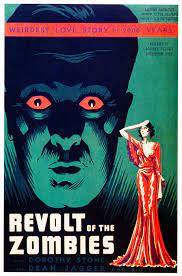
REVOLT OF THE ZOMBIES
US, 1936, 64 minutes, Black and white.
Dean Jagger, Roy Darcy, Robert Noland, Dorothy Stone, Carl Stockdale.
Directed by Victor Halperin.
A historical curio, available on YouTube.
Victor Halperin had made the film, White Zombie, in 1932, with Bela Lugosi. He intended this film is a follow-up, with Lugosi. There were various difficulties, and using the title with zombie, with Lugosi’s presence. Finally, Lugosi’s eyes from the first film are used extensively and atmospherically, superimposed on the action, for the exercise of sinister power.
The 1930s had so many small-budget variations on horror themes. This one seems more eccentric than usual in retrospect.
The opening premise was that there was a group of Cambodian soldiers fighting on the Austrian front for France in World War I. Accompanying them was a priest with a statue for worship and with a painted document, corresponding to an architectural frieze. The premise is that whoever had this power could control others, zombie-like behaviour.
For those expecting zombie sequences (memories of George A.Romero), there is nothing really like this at all.
The priest is murdered while worshipping by a sinister Asian -looking general, Roy Darcy.
The war sequences also introduced to friends, the archaeologist, Armand, an early role for ultimate Oscar-winner, Dean Jagger, earnest in his trying to explain to the generals about the power of the priest. And there is his friend, Robert Noland, urging him to be more forthright and to “ride roughshod” over others.
After the war, there is an expedition to Cambodia, to Angkor Wat, action studio bound but with some authentic backdrops filmed in Cambodia. There is a lot of expected action, exploration on the site, some mysterious accidents, the sinister general reappearing.
And, as with this kind of film the 30s, there are the Americans walking into other cultures with supreme confidence. And, as expected, there is a romance, the archaeologist falling in love with the general’s daughter and she accepting him but provoking his friend. While they become engaged, there is an accident sequence where she takes refuge in the friend in the archaeologist gives her her freedom.
The archaeologist returns to Angkor Wat because the expedition, after the accidents, had returned to Phnom Penh. By accident, in his investigations, he falls down into a subterranean religious maze, confronting the general, killing him, getting the power – and, perhaps to the audience’s surprise, he becomes all controlling, riding roughshod, controlling his servant, controlling the troops, even controlling his friend, the generals, and the wise archaeologist who had given him advice.
How to end all this – true love! The archaeologist continues to declare his love, promising to give up everything for her, but with the servants and troops regaining their power, they all turn on him and destroy him.
An interesting opportunity to look at some of the horror themes of the 1930s moviemaking.